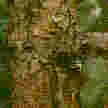
"This Chinese species cannot be confused with any other Abies species because of the unique bark" (van Gelderen et al. 1986).

Line drawing; for full size image go to the Flora of China (Wu and Raven 1999).

A mixed stand of Pinus densata and Abies squamata above the Liqiu River in Sichuan, 2320 m elevation, approximately 29.6°N, 101.35°E [C.J. Earle, 1989.04.21].

Conservation Status

Abies squamata
Masters 1906
Common names
Flaky fir (Vidakovic 1991).
Taxonomic notes
No synonyms (Farjon 1998). The sole species in Section Squamatae E. Murray.
Description
"A tree up to 40 m high. Bark reddish-brown, exfoliating in thin papery layer like that of a birch, even on trees only 6 year of age. Shoots with dense brown hairs. Buds globose, red-brown, very resinous. Needles densely arranged, erect, not pectinate, linear, 1.5-2.5 cm long, rounded or acute apex, bluish green, with 2 white stomata bands on lower surface. Cones oblong-ovate, 5-6 cm long, violet when young; the tips of bract scales protruding past the seed scales, which are 1.5 cm wide" (Vidakovic 1991).
See Wu and Raven 1999 for a more current and detailed description.
Distribution and Ecology
China: W Sichuan alpine zone at 3500-4000m (Silba 1986, Vidakovic 1991); also S Qinghai; E Tibet (Farjon 1998). Hardy to Zone 6 (cold hardiness limit between -23.2°C and -17.8°C) (Bannister and Neuner 2001).
Remarkable Specimens
No data as of 2022.12.31.
Ethnobotany
No data as of 2022.12.31.
Observations
No data as of 2022.12.31.
Remarks
The epithet squamata means "scaly", referring to the bark.
Citations
Masters, M.T. 1906. Gardeners' Chronicle ser. 3, 39:299, f. 121.
See also
The species account at Threatened Conifers of the World.
Farjon, Aljos. 1990. Pinaceae: drawings and descriptions of the genera Abies, Cedrus, Pseudolarix, Keteleeria, Nothotsuga, Tsuga, Cathaya, Pseudotsuga, Larix and Picea. Königstein: Koeltz Scientific Books.
- Provides a detailed account, with illustrations.
Farjon (2010).



